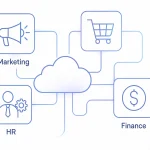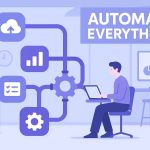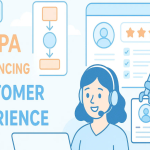End-to-End Workflow Automation for SaaS Businesses: Streamlining Efficiency and Growth

Introduction: The Rise of Workflow Automation in SaaS
In today’s fast-paced digital economy, end-to-end workflow automation has become a game-changer for Software-as-a-Service (SaaS) businesses. From customer onboarding and billing to analytics and customer support, automation enables SaaS companies to streamline repetitive processes, reduce errors, and scale efficiently. As the competition intensifies, organizations leveraging intelligent workflow automation gain a significant edge by improving operational efficiency and customer satisfaction.
What Is End-to-End Workflow Automation?
End-to-end workflow automation refers to the use of automation tools, artificial intelligence (AI), and integrations to connect multiple business processes across departments—ensuring that data flows seamlessly between systems without manual intervention. For SaaS companies, this means connecting CRM, billing systems, marketing platforms, and support tools into a single, cohesive ecosystem.
Key Components of Workflow Automation
- Process Mapping: Identifying manual, repetitive workflows that can be automated.
- Integration: Connecting applications (like Salesforce, HubSpot, and Slack) to enable data exchange.
- Automation Tools: Using platforms such as UiPath, Workato, Make (Integromat), or n8n to execute automated actions.
- Analytics & AI: Leveraging AI for decision-making, pattern recognition, and anomaly detection.
Why SaaS Businesses Need End-to-End Workflow Automation
For SaaS organizations, automation is not just about saving time—it’s about creating an interconnected system that enhances scalability, accuracy, and user experience.
1. Improved Operational Efficiency
Automation minimizes manual tasks such as data entry, customer onboarding, or subscription management. This allows teams to focus on strategic initiatives while ensuring faster processing and fewer human errors.
2. Enhanced Customer Experience
Through integrated CRMs and support systems, customers receive instant responses, personalized communications, and smooth onboarding—leading to improved retention and satisfaction.
3. Seamless Integration Across Tools
SaaS companies often rely on multiple cloud platforms. End-to-end automation ensures that information flows smoothly between marketing, finance, and operations tools, eliminating silos.
4. Data-Driven Decision Making
By integrating analytics dashboards and automation, SaaS companies can generate real-time insights—improving forecasting, product performance monitoring, and KPI tracking.
Practical Use Cases of Workflow Automation in SaaS
1. Customer Onboarding Automation
When a new user subscribes, automation platforms can trigger a sequence—creating an account in CRM, sending welcome emails, provisioning software access, and logging payment details in accounting software.
2. Automated Billing and Subscription Management
By integrating billing tools like Stripe or Chargebee with CRMs such as Salesforce, invoices and renewals are generated automatically, reducing errors and improving cash flow management.
3. Lead Management and Marketing Automation
Tools like HubSpot and Make.com can automatically capture leads from multiple channels, enrich data, and assign them to the appropriate sales representatives—while triggering follow-up email campaigns.
4. Customer Support and Ticket Escalation
When integrated with Zendesk or Freshdesk, automation can classify support tickets by priority, route them to relevant teams, and trigger alerts for high-value customers needing urgent attention.
5. SaaS Renewal and Retention Workflows
Automation can monitor customer usage patterns and proactively alert account managers about at-risk customers, triggering personalized retention campaigns.
How Automation Benefits Each Department in a SaaS Business
1. Sales and Marketing
- Lead scoring and routing automation.
- Email drip campaigns and targeted nurturing.
- Integration between CRM and marketing analytics tools.
2. Finance and Accounting
- Automated invoice generation and reconciliation.
- Real-time revenue recognition and reporting.
- Payment reminders and dunning management.
3. Product and Development
- Automated bug tracking between systems like Jira and GitHub.
- Continuous integration and deployment workflows.
- Real-time reporting on uptime and SLA compliance.
4. Customer Support
- Smart ticket routing and SLA alerts.
- Automated follow-ups and satisfaction surveys.
- AI chatbots for 24/7 assistance.
Tools and Technologies Powering End-to-End Workflow Automation
SaaS businesses have a variety of automation platforms to choose from, depending on their scale, integrations, and technical preferences.
1. UiPath
UiPath offers enterprise-grade robotic process automation (RPA) that can handle complex, rule-based workflows like invoice processing or user provisioning.
2. Workato
Ideal for SaaS-scale integrations, Workato provides pre-built connectors for Salesforce, HubSpot, Slack, and Google Workspace—enabling advanced conditional automations and API workflows.
3. Make (Integromat)
Make offers a visual drag-and-drop interface for designing powerful integrations without coding—perfect for automating lead management and analytics syncs.
4. n8n
An open-source alternative that can be self-hosted, n8n gives businesses complete control over data privacy and scalability with unlimited workflows.
Challenges in Implementing Workflow Automation
Despite its advantages, automation implementation requires strategic planning and cross-department alignment.
- Integration Complexity: Not all SaaS systems offer ready-made APIs, leading to data synchronization issues.
- Change Management: Teams may resist automation due to fear of redundancy or workflow disruption.
- Maintenance & Scalability: Automated workflows must evolve as business processes change.
Best Practices for Successful Automation Implementation
- Start small—automate high-impact, low-complexity tasks first.
- Document workflows clearly before automating.
- Choose platforms that support scalability and integration flexibility.
- Continuously monitor and optimize workflows using analytics dashboards.
Future of Workflow Automation in SaaS
According to Gartner, by 2026, over 70% of SaaS companies will adopt AI-powered automation to manage cross-functional processes. With the integration of generative AI, businesses will be able to automate not just tasks, but also decision-making, forecasting, and personalization at scale.
Conclusion: Empowering SaaS Growth Through Automation
End-to-end workflow automation is no longer a luxury—it’s a necessity for SaaS businesses aiming for sustainable growth. By integrating platforms, leveraging AI, and automating repetitive operations, companies can unlock massive productivity gains and deliver seamless customer experiences. Whether through UiPath, Workato, or n8n, the path to an efficient, scalable SaaS ecosystem begins with strategic automation.
At Deca Soft Solutions, we help SaaS companies design and implement intelligent automation frameworks tailored to their business goals. Contact us to explore how automation can transform your workflows.




